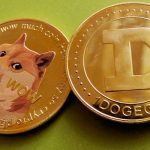Blockchain has changed the world, and no one can deny it. With the introduction of crypto ecosystems like Ethereum, new concepts have appeared meant to transform how people manage their finances.
Decentralized finance has revolutionized the finance sector, and most crypto transactions rely on it. The industry is worth over $210 billion and is expected to gain more popularity in the future since the decentralized system is more secure than centralized ones prone to hacking. All blockchain transactions are transparent, secure and require no intermediaries.
The blockchain has also enabled the creation of non-fungible tokens that are contributing to several spheres like gaming, digital art, and real estate. NFTs are actively collaborating with DeFi to make blockchain processes more effective and bring new ideas and concepts to life. The growth of NFT and DeFi has also influenced the prosperity of exchange platforms like Binance that facilitate purchasing Ethereum and other cryptocurrencies that provide access to blockchain solutions.
This article approaches the idea that non-fungible tokens and decentralized finance are the key pillars of the Ethereum blockchain. Let’s start by finding out more about each of them.
What should you know about DeFi?
DeFi is short for decentralized finance, which is a comprehensive system that includes all the financial applications built on the Ethereum blockchain and other networks that allow it. Anyone who accesses the Ethereum blockchain can also take advantage of decentralized finance. Blockchain technology has entered the financial system as an innovative solution that implies no involvement from a third party to complete transactions, enabling, therefore, the users to retain full control of their finances. Ethereum holders believe that the main advantage DeFi offers is allowing those who cannot access traditional finance to benefit from financial services. And as expected, with more people being able to lend, borrow, and gain interest, the crypto economy has grown in popularity.
What lies behind the DeFi?
Ethereum’s digital currencies and smart contracts are the heart of DeFi because they enable people to benefit from digital services without dealing with an intermediary. Ethereum introduced the concept of smart contracts to replace third parties. They complete transactions when a set of parameters are met. Once the smart contracts go live, no one can alter them, so the transactions go as programmed. Let’s note that all smart contracts are public, so the entire Ethereum community can audit and inspect the transactions.
A list of the most popular DeFi protocols
Suppose you’re interested in decentralized finance, you most likely want to find out what the leading protocols are.
MarkerDAO – all ETH users who also have a MetaMask wallet can loan DAI funds. ETH users can also lock their funds in MakerDAO contracts and borrow users.
Uniswap – it’s one of the decentralized finance applications that gained traction in the Ethereum ecosystem, facilitating the appearance of other DeFi projects like Sushiswap, Curve, and Balancer. ETH holders can use Uniswap to trade digital assets without dealing with a third party. It’s essential to highlight that the protocol doesn’t allow fiat-crypto or crypto-fiat transactions.
Aave – this protocol enables people to borrow and lend digital currencies and traditional assets without the interference of an intermediary or centralized authority. It allows crypto holders to earn interest by lending their digital assets or borrowing crypto assets.
What should you know about non-fungible tokens?
Now let’s discuss non-fungible tokens. They were created as representations of real-life items stored on the blockchain. NFTs take several forms, from real estate to photos, videos, and artwork. They differ from fungible tokens because they have a series of different characteristics. NFTs have gained popularity among artists because they enable them to make a profit on their workers without having to deal with intermediaries like auction houses or galleries.
Gamers also find non-fungible tokens interesting because they can integrate them into their gaming experience and trade in-game assets to improve their performance.
What lies behind NFTs?
NFTs are unique digital assets that allow the ownership of digital items that can be tracked on the blockchain. They are based on smart contracts which allow crypto users to gain ownership. Every time a non-fungible token is minted, a code from the smart contract is executed, and data regarding it is stored on the blockchain
The most important NFT projects
Bored Ape Yacht Club – the most popular collection of non-fungible tokens of the moment, with over 10,000 images of apes.
Crypto Punks – another NFT project that contains a series of art images with random attributes.
Most NFTs were released for free but gained high value as demand increased.
What’s the connection between NFTs and DeFi?
It’s easily understandable that non-fungible tokens are paramount for several operations in the crypto sphere, but let’s find out if they make a difference in the decentralized finance sector.
Central authorities have always controlled traditional finance by supervising all operations, from investments to transactions and trade contracts. However, investors have often seen this as disadvantageous because they were subjected to verification in order to gain approval. Additionally, the traditional finance system is likely to be hacked or subjected to fraud.
Decentralized finance offers solutions to transparency and security issues because it’s based on blockchain technology which doesn’t have any.
In this context, several DeFi projects are integrating non-fungible tokens to provide immutable proof of ownership and store value. Decentralized finance makes performing transactions with non-fungible tokens easier, so the two Ethereum-based technologies are mutually beneficial.
What are the most important cases of NFTs in DeFi?
The integration of NFTs into Defi has numerous benefits for the financial system:
– Loan collateralization – NFT makes it easier to secure collateralized loans because the borrower can use tokens to mitigate the risks.
– Fractional ownership – it facilitates dividing the price between multiple buyers to make the digital asset more liquid.
– Insurance – insurance policies can be converted into non-fungible tokens to be sold, bought or transferred.
– Debt management – companies can use smart contracts to handle recurrent operations like calculations and approvals to limit human error.
It’s easily understandable why people name NFTs and DeFi the pillars of the Ethereum blockchain now that they have merged and level up the benefits they offer.












